|
|
||
| Back
|
Day 16 - Leningradskaya |
| This journal is constructed as one web page for each day of my journey, including the arrival day in Auckland, and the final two days, which I spent in Hobart. I have tried to keep the picture images of a reasonable size for easy web page loading. To see a much larger view of (practically) any image, just left-click on the photo. |
|
|
|
I
was up on the bridge before breakfast, taking in the views of our last
day along the Antarctic coast. Our trip leader, Jane, was having
somewhat of a heated discussion with the bridge officer. It seemed
to involve the morning visit to the abandoned Soviet station,
Leningradskaya, as in whether it will take place or not. They
resolved their differences, and I was glad to stay as far away from that
as possible. While the station is located high on a cliff, right
at the edge of the continent, we are still some 23 miles away, at the
edge of the ice that stretches out this far even at the height of
summer!
Early in the morning, Jane, and the staff, flew to the station to set up our operations there, and then we started our shuttle process. I was in the second group to go, so there wasn't much waiting. We did have to time our return - these events take a long time to play out, even when well-coordinated. It took us about 20 minutes of flying, due south, to reach our objective, and what a sight it was! |
|
Although
poised atop an impressive cliff, there is a gentle slope to the south,
where much of the supplies were located. There is a lot
here. The station was abandoned in 1991, after twenty years in
service. And, it looked like they left in a hurry, without
bothering to secure the station and pack things away. There are
many modular buildings here. One had the ice starting to fill it
up. We could walk around anywhere, just taking care not to hurt
ourselves nor the structures. There were at least three vehicles
here, a trash dump of many fuel barrels, and an intriguing globe
structure, probably housing more sensitive communications, or recording,
instruments.
We did get to see inside a couple of the "huts." In one, there were 20+ pairs of what someone called "gumboots." Also, a nearby pile of felt liners, all ready to put on, and sleeping bags. I was able to get into another hut, which I think was being discouraged for later arrivals. It was just a small room, but full of interesting things, as you can see from the photos below - a tin of coffee on a shelf (India Brand), some powered milk ("Leche," so of Spanish origin), old newspapers (but in excellent condition), pots and pans, rusty saws and some keys. It was quite fun walking around this site - I believe we are only the third party to visit since it closed down. We had about an hour, and could have spent a day here, but such is the demand of time on our expedition. |
|
|
||
|
|
||
| In the afternoon, it was time for my group's tour of the engine room. These tours started early in the trip, but we don't have all that many days available for them, with all the other activities that we are involved with. So, we were one of the last ones for this tour. The chief engineer, who has worked on the KK since 1983, took us around. His English was fine, but he carried signs to hold up, since the noise can be quite deafening (in fact, we were all given some earplugs). But the ship is moored in the ice for now (while the trips to Leningradskaya continue), so it isn't all that noisy, nor busy. It was fun to wander down through the bowels of the ship - there is a lot here, and we don't usually see any of it. |
| In the late evening, I spent many hours on the bridge, as did the usual gang. It was quite mesmerizing to watch us crunch through the ice, and, of course, we are sad to be leaving the continent behind us. We were treated to a sunset, although it wasn't until about 12:30 a.m., and "night" didn't last but a couple of hours. I decided to get some photos of the setting sun, and it sure took a long time. Instead of heading straight down to the horizon, the sun sets at a very low angle. When I started getting serious about following the progress of the sunset, it still took an hour and a half for it to set! I also took some interesting pictures of the ice reflecting the light near sunset, and some cool photos of the ship in sepia tone and black & white. I had thought I might get to see the green flash, but, alas, not yet. |
|
|
||
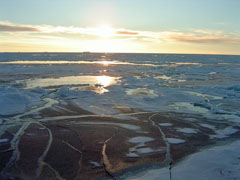 |
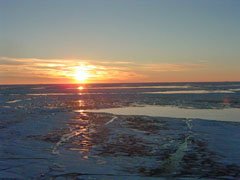 |
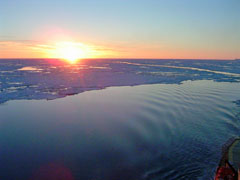 |
| Sunset minus 90 minutes. | Sunset minus 36 minutes. | Sunset minus 20 minutes. |
|
|
||
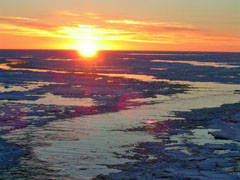 |
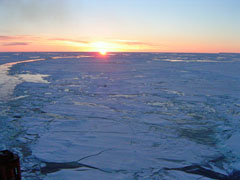 |
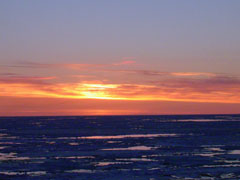 |
| Sunset minus 10 minutes. | Sunset minus 7 minutes. | Sunset! |
|
|
||
|
Sunset
minus 25 minutes behind |
Sunset
minus 25 minutes behind |
|
| As it got dark, it got . . . cold! What an odd feeling. We haven't had any night for so long, that I was startled by the sudden change in temperature. We will soon be heading into rougher seas, but we do have another visit for tomorrow - the Balleny Islands. |
|
|
| Follow the "Next" and "Back" links to go from page to page. Or, return to the "Antarctica Home Page" and link to any day from the "Daily Logs" shown there. If you have any comments, e-mail me to me at: dfoster<at>kaibabjournal<dot>com. Please put “Antarctica” in the subject category. |